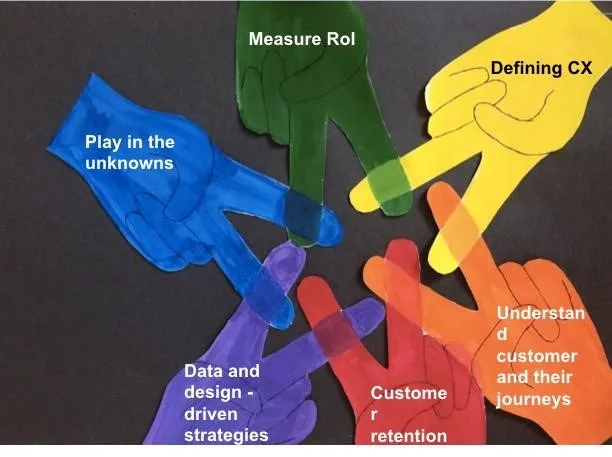How you can transform your organisation into a customer-centric one
We all know that customer is king, but it’s getting trickier and more complicated by the day to retain his attention and loyalty. Here are some good examples of companies adapting to the times to keep their customers happy.

It’s the start of a new year, and I see my mailbox flooded with mails on taking a dime a dozen surveys, right from how we see marketing landscape expanding, role of technology in marketing, changing expectations of customers, and many more. In all of these questions and surveys there is one underlying focus and that is the all big bad wolf standing at the threshold – customer experience.
According to a Forrester Research article, the marketer has evolved. Today’s marketers need to be “whole-brained”, which means bringing together both sides of their brains:
- The right side, which designs experiences to engage customers
- The left side, which masters technology and analytics to deliver personalised, contextually rich experiences
The kind of marketers is in the minority currently. But, soon, they will be the competency standard for both B2C and B2B companies. Marketers who have been comfortable dabbling in the area of design and brand look as sitting on a chair of nails when they are exploring or adopting the full mantle of technology. On the other hand, marketers who are data or analytics-driven are extremely uncomfortable to be dealing with grey areas like design, brand etc.
So how can marketers effectively approach customer experience?
Let us look at a prismatic colour wheel; it’s a got a natural system of colours. The centrepoint of the circle is a black dot that is the amalgamation of all the primary colours. Similarly, if the customer experience (or CX) is at the centrepoint, then there are six primary areas that I have identified that marketers need to work towards ensuring all their activities are centred around CX.

- Define customer experience (CX)– Any CX programme is successful only if the customer has an experience that exceeds, or is in line with their needs. This means right from the person in the front line interacting to the customer right to the back end, so that organisations have the data to provide insights through the entire customer lifecycle of interaction with the product or service.
We are increasingly seeing that customer experience is a key responsibility area of many Chief Marketing Officers (CMO) and Chief Digital Officers (CDO). They look at how all their strategies and vision are customer-centric with the aim of creating superlative customer experience. For example, a very large consumer electronics company that specialises in connectivity devices in the Bay Area has their CMO, whose key success measure is customer experience. Right from customer support, to outreach and customer experience surveys or voice of customer inputs, everything is available to the entire team. So, defining the smallest metric that can define customer experience and use it to measure customer experience is key. This, in turn, helps them design programmes, which gives them an inkling of customers’ expectations and needs.
- Understand customer and journeys: Understanding customers and their journeys is essential to creating lasting experience and improving customer stickiness and loyalty. Marketing teams will need to understand the different customer personas and design campaigns tailored to them to get the maximum success. Marketing data insights or analytics provide true and real-time insights using IoT sensors or pattern mapping based on customer journey patterns in their system. One of the best practices most large enterprises adopt is creating robust personas, mapping onto the industry best practices and testing this hypothesis with a real-time feedback loop to continuously improvise and test it back in the market.
Once the customer is understood the next is to look at the different ways the enterprise can engage with the customer on their journey. What we have seen with the digital customer is that they would like to research about the product by reading reviews and also hearing views from trusted peer groups.
They are more often than not using a mobile or a web browser channel to complete the purchase. Some of these decisions are also dependent on the post-service options and the experience their peer group has described. It’s essential that one needs to design a progressive customer journey and tap on the engagement opportunities with relevant insights.
For example, a friend of mine was looking to buy a sedan a couple of years ago. He whittled down his options to Hyundai Verna, Skoda Rapid and Volkswagen Vento. He read the reviews of all the cars and spoke to friends about these three cars. He was told that all of these cars were great in terms of performance. But what got Skoda out of the race was the bad experience he had with a leading dealer in Bengaluru. He met them, and after multiple calls, he got to test drive the car and despite reaching out to the showroom several times he did not get a call back, which made him drop Skoda from the list. Now the car was great, but the prospect could not be completed as the dealer did not engage the customer, and failed to realise that my friend was actually a “serious buyer”. Between Volkswagen and Hyundai, Hyundai was the final choice, as the post car care service was rated much better. He also had a Hyundai car earlier, and a pleasant experience while dealing with the service team. The cars, in this case, were great (which means product meets customer needs) but the customer and their buying journey wasn’t understood, which led him to shortlist a car based on his earlier experience without a challenge.
- Customer retention: Managing customer retention rate is an incredibly important part of growing a sustainable business. According to a Harvard Business Review research, it costs 150 percent more to acquire a new customer. Also, the same research points out that increasing customer retention rates by five percent increases profits by 25 percent to 95 percent. So, it’s pure economics on how can we retain the customer who is already converted. But how do you create a customer retention strategy that keeps your current customers engaged and happy?
Customers usually like to be associated with a brand and what it stands for, not the engagement tactics or services. If you want loyal customers, you need to create real connections with them. You must also focus on creating the right experience for them when they associate with your brand.
If customers don't enjoy your education, marketing, and sales engagement, they’re highly unlikely to do business with you again. Selling to customers the right way is an integral part of creating customer loyalty.
For example, let’s see Starbucks, which has set the bar on customer experience quite high. Starbucks beverages are expensive, yet they are able to get their customer to walk into their outlets every morning. It all comes down to their customer retention strategies in creating the right experiences that are curated by their marketing teams. In the early days, Starbucks founders focused on the sounds and the smells inside their shops in order to provide a delightful customer experience. But to grow in the highly competitive market, they had to get innovative. One of their most innovative customer retention moves is their Mobile Order & Pay feature within their app. Thanks to the new feature, customers can order their coffee before they even arrive at the shop. Now their customers can shave more than 10 minutes off their busy schedules when they come to pick up their coffees.
What this means is to make products and services as accessible as possible to your customers. Pre-identify behaviours and wants of customers and use them as inputs to create tools and systems that empower them. Whether that be an app, a new loyalty or social programme or other traditional methods of engaging with the customer, it’s up to you.
- Data and design-driven strategies: Almost every successful enterprise recognises that it is in the customer-experience business. Some of these successful enterprises are Amazon, Uber, Walt Disney and also the US Air Force. Their strategies are customer-driven. Gathering, segmenting and analysing data are classic starting points in understanding customers. But data is not enough; it’s insights that matter. Data is the new oil, meaning that those who control it wield the power. According to research by McKinsey, they feel that successful customer-experience efforts apply a human filter to the collected data to ask overarching questions. Exactly who are my customers as individuals? What motivates them? What do they want to achieve? What are the fundamental causes of satisfaction? Obviously, tackling these questions requires a concerted analytical effort, which helps an organisation design and implement a more sophisticated programme and, critically, persuade employees to embrace its goals. This needs an underlying robust design and data strategy that can see how the insights can actually create a memorable experience.

As a case in point. For close to a century, Disney has prided itself in producing magical guest experiences that few can match. But in mid-2000s the long queues and the high ticket prices started to take the shine off the Disney experience. To combat this, Disney charted out a strategy called the ‘next generation experience project’. Focusing on creating “more immersive, more seamless, and more personal experiences for each and every guest,” the team has four goals: driving operational efficiency, transforming the customer experience, personalisation through connected products, and enhancing interactivity across channels.
Disney’s MyMagic+ is a high-tech, billion-dollar initiative that eliminates these inconveniences with personalisation and connected technologies.
It allows guests to book ride times, make restaurant reservations and buy tickets for shows in advance using the website. When they arrive at the park, alerts from the smartphone app remind them it’s time to enjoy their selected activities. The mobile app allows guests to change reservations in real time as needed and allows payments to be made through it. MagicBands acts as an admission ticket, the key to the hotel room, and a FastPass+.
The results have been very promising. The new system helped Disney accommodate 3,000 extra daily visitors during the 2013 Christmas holiday season by managing advanced reservations for high demand rides. That same year, theme parks made up a third of Disney’s $45 billion total revenue and 20 percent of its operating profit.
- Play in the unknowns: If we examine the customer experience journey, we will be able to identify areas that are just right for improvement. This has a large impact on the customer experience as well as ability to transform the customer journey.
For example, let’s look at Amazon and some of its initiatives through which it locks down its customers and also gains control of their journey. Iexploring renting locker units as Amazon lockers in buildings to serve its customers. In other words, it is trying to offer an alternative to the UPS service; This will ensure Amazon is aware of its delivery process works. This also ensures that delivery is predictable and gives lesser chance for a break in or damages. The other example is Amazon delivering groceries into your home or at a designated area like a garage or a shed. Initially, Twitter was blowing up with tweets discussing issues around security or privacy of having a stranger inside even the designated area, but what was surprising was the number of loyal customers who also welcomed this move.
Once this becomes mainstream it will give Amazon the predictability of the packages arriving on time with no damage. I love the dash buttons, which allow Amazon to be part of a customer’s journey constantly. You are off washing powder, then all you need to do is hit the Tide dash button close to the washer, and the powder is ordered and set to be delivered. The latest to this is Amazon Go. This is a new kind of store with no checkout required. They have created shopping technology where the shopper does not need to wait in a line to check out. With their Just Walk Out Shopping experience, one has to simply use the Amazon Go app to enter the store, take the products one wants, and go! No lines, no check out. This is also their foray in creating great experiences both online and offline. This should make the other offline retailers sit up and take note of how Amazon is playing in the unknown and creates sticking customer experience.
- Measure RoI: It’s extremely critical that teams measure what they spend on to understand what strategy, programmes, technology, and channels are working and what aren’t. There is no uniform template or framework, as each company’s measurement is based on the outreach, but some metrics or KPIs like Net Promoter Score, CSAT, can help understanding parts of the journey, They can, however, never provide the complete view.
According to customer strategy expert Jeanne Bliss, the principle of treating your customers as assets requires measuring the impact of the end-to-end customer experience. It measures what customers actually did (through their behaviours), versus what they say they are going to do (via surveys). Most importantly, “customers as assets” shifts the conversation from achieving sales or a survey score to caring about why customer behaviour changed as a result of their journey with you. Start creating measures on how many customers you acquired in absolute numbers, and how many customers you lost in absolute numbers. Then analyse data to arrive at insights on whether you grow or shrunk in asset, and also track this entire operation and not just sales.
This analysis will help measure and optimise efforts.
In conclusion, take baby steps. Best is to start small with a strategy to scale. Having the right team to deliver a campaign or improve areas of the customer journey is essential. Central to the success of this programme is selecting a campaign or project that allows the team to test the entire approach while measuring success at every stage. This will also provide the team and the leaders the investments required in terms of technology, expertise or inputs for strategy while creating a cross-functional marketing model.
(Disclaimer: The views and opinions expressed in this article are those of the author and do not necessarily reflect the views of YourStory.)







